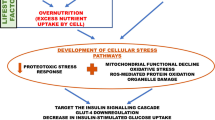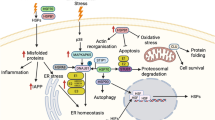Abstract
Induction of heat shock proteins (Hsp) 72 and 27 can improve insulin signalling in obesity and type 2 diabetes via inhibition of key stress kinases. In metabolic disease, altered insulin signalling, as illustrated by increased serine phosphorylation of insulin receptor substrate (IRS)-1 (Ser312), is not confined to muscle or liver and can also affect other tissues and cell types, potentially impairing their primary biological function. This study specifically investigated insulin-stimulated glucose metabolism in monocytes and examined the impact of HSP induction on insulin signalling. Control (CG, BMI < 25 kg/m2) or obese (OG, BMI > 30 kg/m2) participants were included in the study. Glucose transporter (GLUT)4 expression on monocytes, phosphorylated JNK, IKK-β and IRS-1, as well as Hsp27 and Hsp72, were measured in monocytes under fasting conditions. GLUT4 expression was also measured during an oral glucose tolerance test (OGTT). HSP induction as well as JNK, IKK-β activation and IRS-1 serine phosphorylation was investigated following heat stress. Obese patients showed lower GLUT4 levels on monocytes during the OGTT. pJNK, pIKK-β and pIRS-1 levels were increased in OG with pJNK and pIKK-β levels positively correlated with serine pIRS-1 and negatively with GLUT4 supporting their role in insulin resistance. Heat exposure induced Hsp72 and Hps27, but only in CG for the latter, and decreased pJNK, pIKK-β and pIRS-1. Our results show that induction of Hsp72 and 27 via heat stress is associated with inactivation of stress kinases and reduced serine pIRS-1 in monocytes from obese participants. This indicates that metabolic diseases can also affect monocyte metabolism via cellular stress that can be modulated via HSP induction.




Similar content being viewed by others
References
Adams JM, Pratipanawatr T, Berria R, Wang E, DeFronzo RA, Sullards MC, Mandarino LJ (2004) Ceramide content is increased in skeletal muscle from obese insulin-resistant humans. Diabetes 53:25–31
Akira S (2003) Toll-like receptor signaling. J Biol Chem 278:38105–38108
Beeson M, Sajan MP, Dizon M, Grebenev D, Gomez-Daspet J, Miura A, Kanoh Y, Powe J, Bandyopadhyay G, Standaert ML, Farese RV (2003) Activation of protein kinase C-zeta by insulin and phosphatidylinositol-3,4,5-(PO4)3 is defective in muscle in type 2 diabetes and impaired glucose tolerance: amelioration by rosiglitazone and exercise. Diabetes 52:1926–1934
Bruce CR, Carey AL, Hawley JA, Febbraio MA (2003) Intramuscular heat shock protein 72 and heme oxygenase-1 mRNA are reduced in patients with type 2 diabetes. Diabetes 52:2338
Bryant NJ, Govers R, James DE (2002) Regulated transport of the glucose transporter GLUT4. Nat Rev Mol Cell Biol 3:267–277
Chung J, Nguyen A-K, Henstridge DC et al (2008) HSP72 protects against obesity-induced insulin resistance. Proc Natl Acad Sci USA 105:1739–1744
Dasu MR, Jialal I (2010) Free fatty acids in the presence of high glucose amplify monocyte inflammation via toll-like receptors. Am J Physiol Endocrinol Metab 300:E145–E154
Devaraj S, Dasu MR, Rockwood J, Winter W, Griffen SC, Jialal I (2008) Increased toll-like receptor (TLR) 2 and TLR4 expression in monocytes from patients with type 1 diabetes: further evidence of a proinflammatory state. J Clin Endocrinol Metab 93:578
Dimitriadis G, Maratou E, Boutati E, Psarra K, Papasteriades C, Raptis SA (2005) Evaluation of glucose transport and its regulation by insulin in human monocytes using flow cytometry. Cytometry A 64:27–33
Expert Committee on the Diagnosis and Classification of Diabetes Mellitus (2003) Report of the Expert Committee on the Diagnosis and Classification of Diabetes Mellitus. Diabetes Care 26(Suppl 1):S5–S20
Gao Z, Hwang D, Bataille F, Lefevre M, York D, Quon MJ, Ye J (2002) Serine phosphorylation of insulin receptor substrate 1 by inhibitor kappa B kinase complex. J Biol Chem 277:48115–48121
Gupte AA, Bomhoff GL, Swerdlow RH, Geiger PC (2009) Heat treatment improves glucose tolerance and prevents skeletal muscle insulin resistance in rats fed a high-fat diet. Diabetes 58:567–578
Gupte AA, Bomhoff GL, Touchberry CD, Geiger PC (2011) Acute heat treatment improves insulin-stimulated glucose uptake in aged skeletal muscle. J Appl Physiol 110:451–457
Hooper PL, Hooper PL (2009) Inflammation, heat shock proteins, and type 2 diabetes. Cell Stress Chaperones 14:113–115
Kipmen-Korgun D, Bilmen-Sarikcioglu S, Altunbas H, Demir R, Korgun ET (2009) Type-2 diabetes down-regulates glucose transporter proteins and genes of the human blood leukocytes. Scand J Clin Lab Investig 69:350–358
Kohn G, Wong HR, Bshesh K, Zhao B, Vasi N, Denenberg A, Morris C, Stark J, Shanley TP (2002) Heat shock inhibits tnf-induced ICAM-1 expression in human endothelial cells via I kappa kinase inhibition. Shock 17:91–97
Kokura S, Adachi S, Manabe E, Mizushima K, Hattori T, Okuda T, Nakabe N, Handa O, Takagi T, Naito Y, Yoshida N, Yoshikawa T (2007) Whole body hyperthermia improves obesity-induced insulin resistance in diabetic mice. Int J Hyperthermia 23:259–265
Maratou E, Dimitriadis G, Kollias A, Boutati E, Lambadiari V, Mitrou P, Raptis SA (2007) Glucose transporter expression on the plasma membrane of resting and activated white blood cells. Eur J Clin Invest 37:282–290
McCarty MF (2006) Induction of heat shock proteins may combat insulin resistance. Med Hypotheses 66:527–534
Morino K, Petersen KF, Shulman GI (2006) Molecular mechanisms of insulin resistance in humans and their potential links with mitochondrial dysfunction. Diabetes 55(Suppl 2):S9–S15
Park HS, Lee JS, Huh SH, Seo JS, Choi EJ (2001) Hsp72 functions as a natural inhibitory protein of c-Jun N-terminal kinase. EMBO J 20:446–456
Park K-J, Gaynor RB, Kwak YT (2003) Heat shock protein 27 association with the I kappa B kinase complex regulates tumor necrosis factor alpha-induced NF-kappa B activation. J Biol Chem 278:35272–35278
Petersen KF, Shulman GI (2006) Etiology of insulin resistance. Am J Med 119:S10–S16
Shoelson SE, Lee J, Yuan M (2003) Inflammation and the IKK beta/I kappa B/NF-kappa B axis in obesity- and diet-induced insulin resistance. Int J Obes Relat Metab Disord 27(Suppl 3):S49–S52
Shoelson SE, Lee J, Goldfine AB (2006) Inflammation and insulin resistance. J Clin Invest 116:1793–1801
Simar D, Malatesta D, Badiou S, Dupuy AM, Caillaud C (2007) Physical activity modulates heat shock protein-72 expression and limits oxidative damage accumulation in a healthy elderly population aged 60 90 years. J Gerontol A Biol Sci Med Sci 62:1413–1419
Strle K, Broussard SR, McCusker RH, Shen W-H, LeCleir JM, Johnson RW, Freund GG, Dantzer R, Kelley KW (2006) C-jun N-terminal kinase mediates tumor necrosis factor-alpha suppression of differentiation in myoblasts. Endocrinology 147:4363–4373
Wallace TM, Levy JC, Matthews DR (2004) Use and abuse of HOMA modeling. Diabetes Care 27:1487–1495
Yoo CG, Lee S, Lee CT, Kim YW, Han SK, Shim YS (2000) Anti-inflammatory effect of heat shock protein induction is related to stabilization of IκBα through preventing IκB kinase activation in respiratory epithelial cells. J Immunol 164:5416–5423, Baltimore, Md: 1950
Zick Y (2005) Ser/Thr phosphorylation of IRS proteins: a molecular basis for insulin resistance. Science's STKE 2005: pe4
Acknowledgments
This work was supported by the University of New South Wales (starting funds to Dr. David Simar). The authors would like to thank the participants for their time and patience, as well as Dr. Pat Ruell and Ms. Ashley Armstrong for technical assistance.
Author information
Authors and Affiliations
Corresponding author
Rights and permissions
About this article
Cite this article
Simar, D., Jacques, A. & Caillaud, C. Heat shock proteins induction reduces stress kinases activation, potentially improving insulin signalling in monocytes from obese subjects. Cell Stress and Chaperones 17, 615–621 (2012). https://doi.org/10.1007/s12192-012-0336-4
Received:
Revised:
Accepted:
Published:
Issue Date:
DOI: https://doi.org/10.1007/s12192-012-0336-4




